Chocolate company Hershey (NYSE:HSY) reported results ahead of analysts' expectations in Q1 CY2024, with revenue up 8.9% year on year to $3.25 billion. It made a non-GAAP profit of $3.07 per share, improving from its profit of $2.96 per share in the same quarter last year.
Hershey (HSY) Q1 CY2024 Highlights:
- Revenue: $3.25 billion vs analyst estimates of $3.11 billion (4.5% beat)
- EPS (non-GAAP): $3.07 vs analyst estimates of $2.76 (11.2% beat)
- Reiterated full year outlook for sales and EPS (non-GAAP) growth
- Gross Margin (GAAP): 51.5%, up from 46.3% in the same quarter last year
- Organic Revenue was up 8.6% year on year
- Sales Volumes were up 3.4% year on year
- Market Capitalization: $40 billion
Best known for its milk chocolate bar and Hershey's Kisses, Hershey (NYSE:HSY) is an iconic company known for its chocolate products.
The company was founded in 1894 by Milton S. Hershey, and it set itself apart from the crowd with its commitment to using high-quality ingredients and a special manufacturing process known as conching, which gives its chocolate a smooth and creamy texture.
In addition to its simple milk chocolate bar and signature Kiss wrapped in foil, Hershey is also known for Reese's Peanut Butter Cups, Kit Kat, Twizzlers, and Jolly Rancher hard candies. Hershey’s appeal is broad, but its core customer is someone with a sweet tooth. The company’s products are often associated with celebratory moments such as trick-or-treating on Halloween or roasting s’mores with your family. Despite trends in health and wellness, consumers still seek treats that provide moments of happiness.
Hershey's products can be found in a wide range of retail outlets such as grocery stores, convenience stores, drugstores, mass merchandisers, and even online retailers. In response to shifting consumer habits, Hershey also has an online store where customers can purchase Hershey products, merchandise, and gifts for others directly from the company.
Shelf-Stable Food
As America industrialized and moved away from an agricultural economy, people faced more demands on their time. Packaged foods emerged as a solution offering convenience to the evolving American family, whether it be canned goods or snacks. Today, Americans seek brands that are high in quality, reliable, and reasonably priced. Furthermore, there's a growing emphasis on health-conscious and sustainable food options. Packaged food stocks are considered resilient investments. People always need to eat, so these companies can enjoy consistent demand as long as they stay on top of changing consumer preferences. The industry spans from multinational corporations to smaller specialized firms and is subject to food safety and labeling regulations.
Competitors that offer chocolate products and treats include Crunch from Nestle (SWX:NESN), Cadbury and Toblerone from Mondelez (NASDAQ:MDLZ), and M&M's and Snickers from private company Mars.Sales Growth
Hershey is one of the larger consumer staples companies and benefits from a well-known brand, giving it customer mindshare and influence over purchasing decisions.
As you can see below, the company's annualized revenue growth rate of 10.8% over the last three years was decent despite selling a similar number of units each year. We'll explore what this means in the "Volume Growth" section.
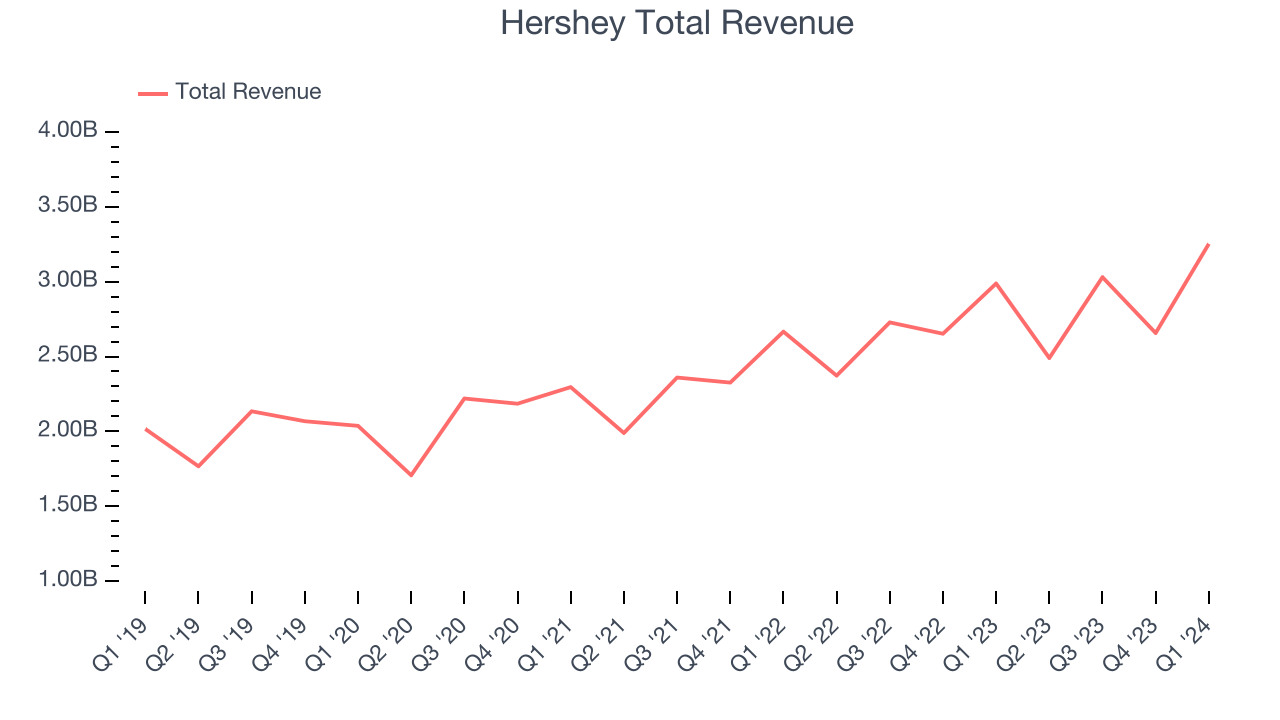
This quarter, Hershey reported solid year-on-year revenue growth of 8.9%, and its $3.25 billion in revenue outperformed Wall Street's estimates by 4.5%. Looking ahead, Wall Street expects revenue to remain flat over the next 12 months, a deceleration from this quarter.
Volume Growth
Revenue growth can be broken down into changes in price and volume (the number of units sold). While both are important, volume is the lifeblood of a successful staples business as there’s a ceiling to what consumers will pay for everyday goods; they can always trade down to non-branded products if the branded versions are too expensive.
To analyze whether Hershey generated its growth from changes in price or volume, we can compare its volume growth to its organic revenue growth, which excludes non-fundamental impacts on company financials like mergers and currency fluctuations.
Over the last two years, Hershey's quarterly sales volumes have, on average, stayed about the same. This stability is normal as the quantity demanded for consumer staples products typically doesn't see much volatility. The company's flat volumes also indicate its average organic revenue growth of 8.9% was generated from price increases.
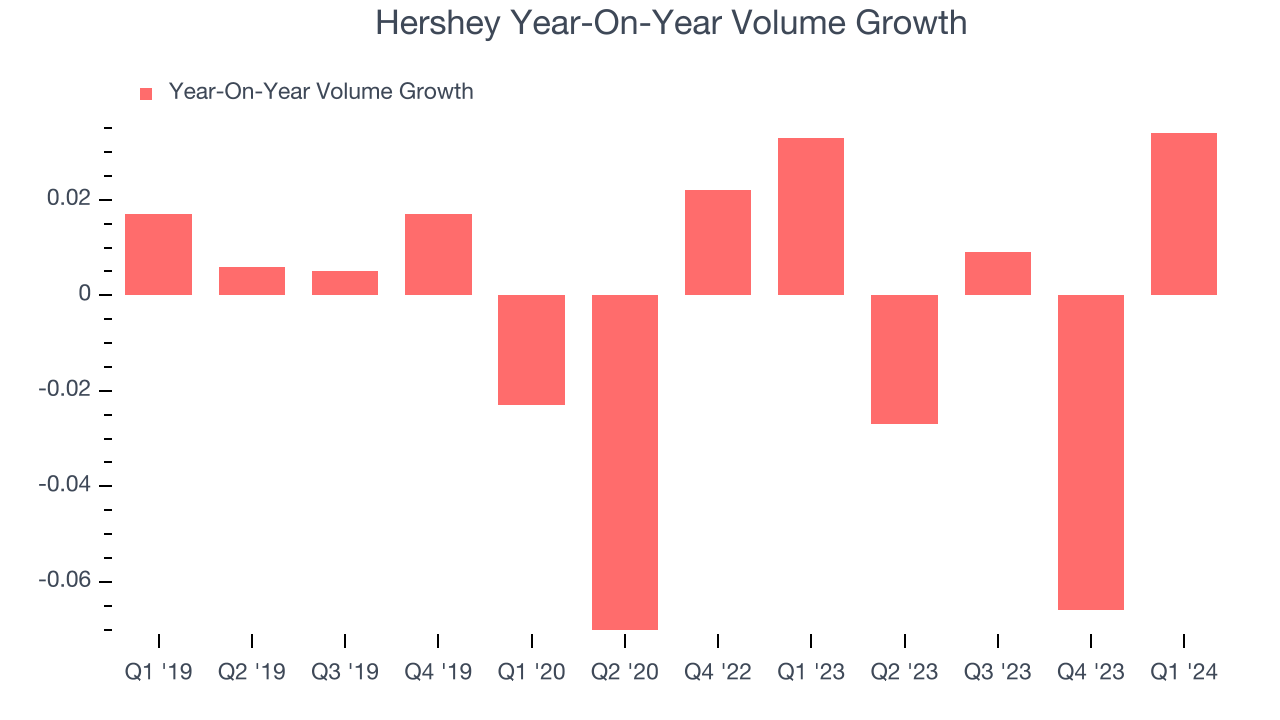
In Hershey's Q1 2024, sales volumes jumped 3.4% year on year. This result was in line with the 3.3% year-on-year increase it posted 12 months ago.
Gross Margin & Pricing Power
This quarter, Hershey's gross profit margin was 51.5%, up 5.2 percentage points year on year. That means for every $1 in revenue, $0.48 went towards paying for raw materials, production of goods, and distribution expenses.
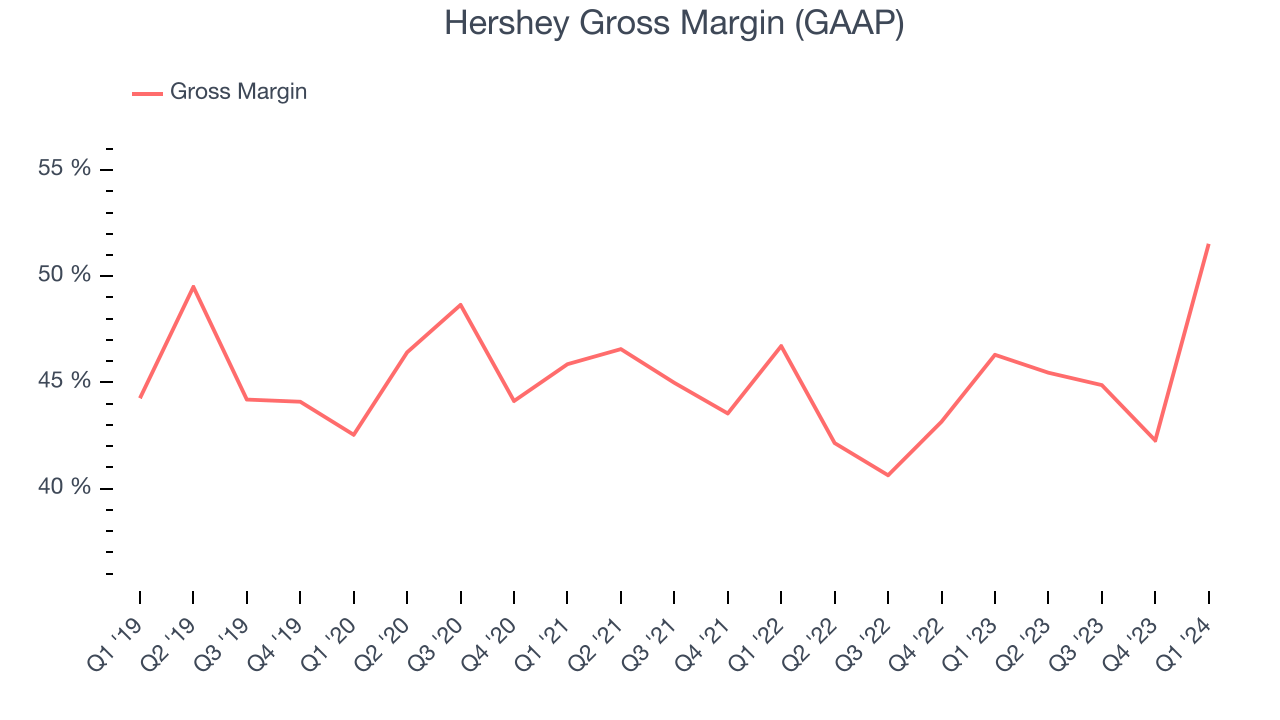
Hershey has good unit economics for a consumer staples company, giving it the opportunity to invest in areas such as marketing and talent to stay competitive. As you can see above, it's averaged a healthy 44.8% gross margin over the last two years. Its margin has also been trending up over the last 12 months, averaging 6.9% year-on-year increases each quarter. If this trend continues, it could suggest a less competitive environment where the company has better pricing power and more favorable input costs (such as raw materials).
Operating Margin
Operating margin is an important measure of profitability accounting for key expenses such as marketing and advertising, IT systems, wages, and other administrative costs.
In Q1, Hershey generated an operating profit margin of 32.5%, up 5.8 percentage points year on year. This increase was encouraging, and we can infer Hershey was more efficient with its expenses because its operating margin expanded more than its gross margin.
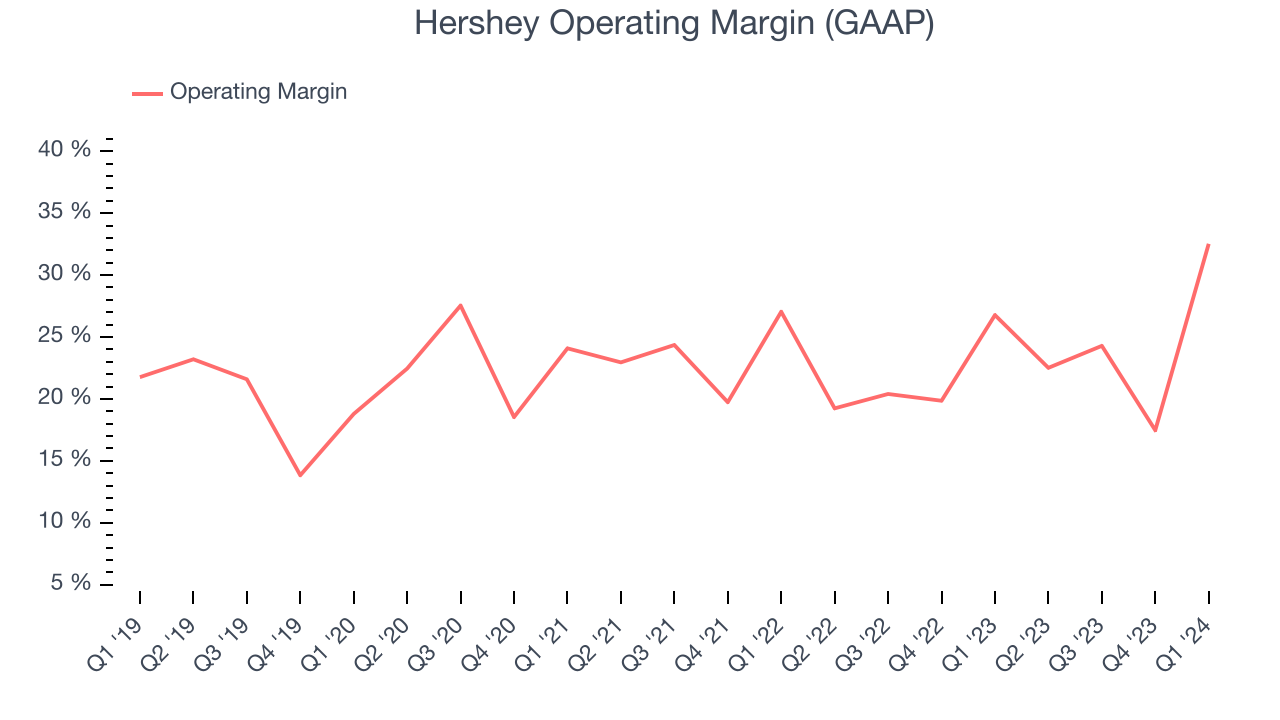 Zooming out, Hershey has been a well-oiled machine over the last two years. It's demonstrated elite profitability for a consumer staples business, boasting an average operating margin of 23.3%. On top of that, its margin has improved by 2.9 percentage points on average over the last year, a great sign for shareholders.
Zooming out, Hershey has been a well-oiled machine over the last two years. It's demonstrated elite profitability for a consumer staples business, boasting an average operating margin of 23.3%. On top of that, its margin has improved by 2.9 percentage points on average over the last year, a great sign for shareholders. EPS
Earnings growth is a critical metric to track, but for long-term shareholders, earnings per share (EPS) is more telling because it accounts for dilution and share repurchases.
In Q1, Hershey reported EPS at $3.07, up from $2.96 in the same quarter a year ago. This print beat Wall Street's estimates by 11.2%.
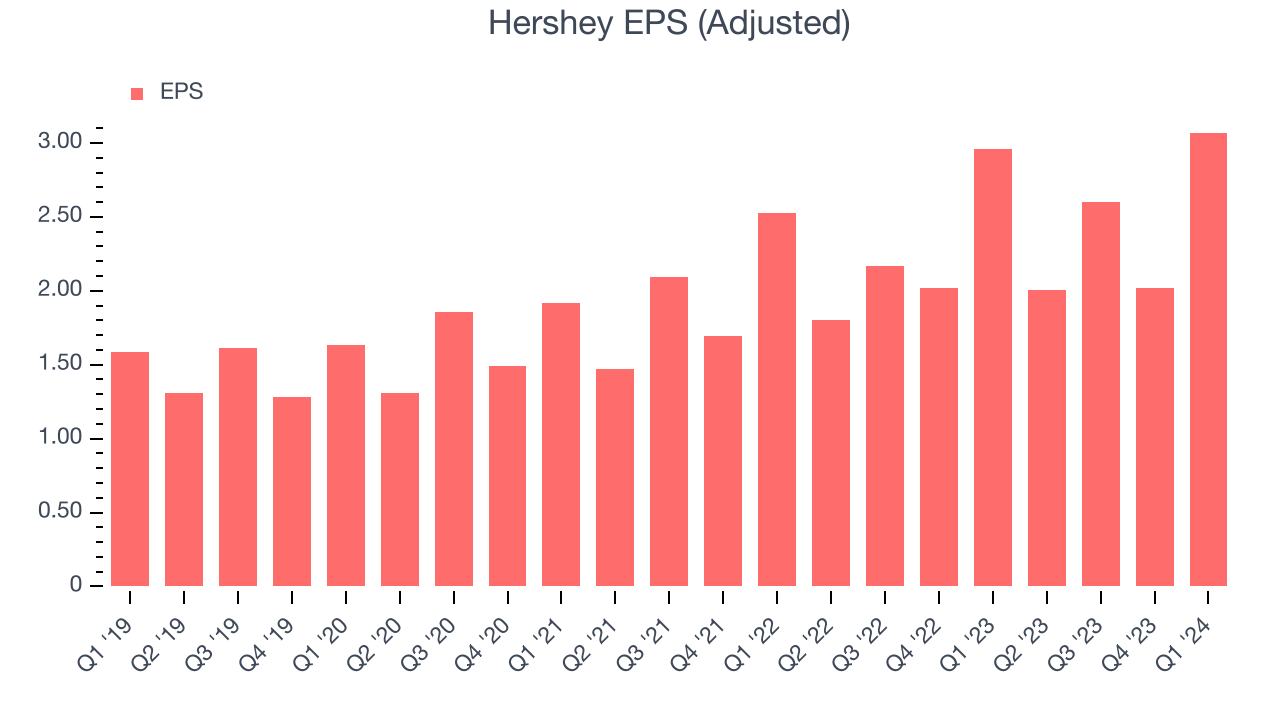
Between FY2021 and FY2024, Hershey's EPS grew 47.5%, translating into a solid 13.8% compounded annual growth rate.
Over the next 12 months, however, Wall Street is projecting Hershey's EPS to stay flat.
Return on Invested Capital (ROIC)
EPS and free cash flow tell us whether a company was profitable while growing revenue. But was it capital-efficient? A company’s ROIC explains this by showing how much operating profit a company makes compared to how much money the business raised (debt and equity).
Hershey's five-year average ROIC was 27.7%, placing it among the best consumer staples companies. Just as you’d like your investment dollars to generate returns, Hershey's invested capital has produced excellent profits.
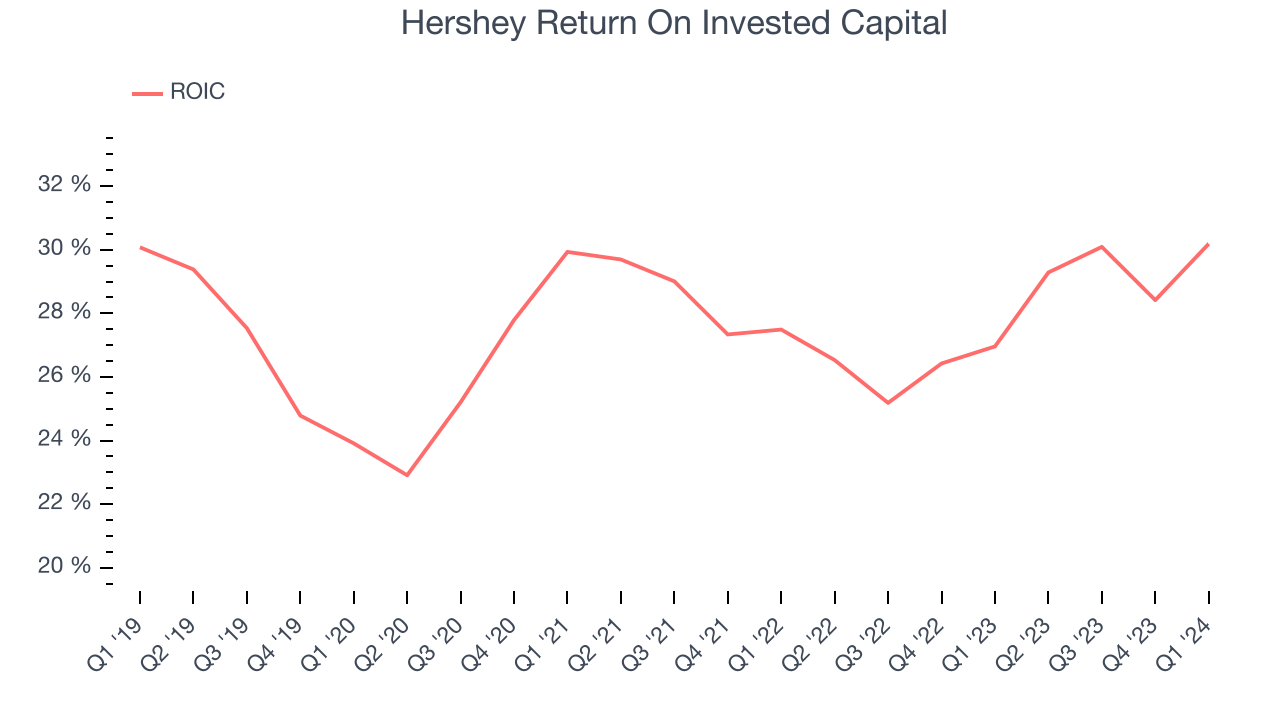
The trend in its ROIC, however, is often what surprises the market and drives the stock price. Over the last few years, Hershey's ROIC averaged 1.7 percentage point increases. The company has historically shown the ability to generate good returns, and its rising ROIC is a great sign. It could suggest its competitive advantage or profitable business opportunities are expanding.
Key Takeaways from Hershey's Q1 Results
We liked that gross and operating margin beat analysts' expectations this quarter. That the company reiterated its full year guidance means it's staying squarely on track. Zooming out, we think this was a solid quarter. The stock is up 2.6% after reporting and currently trades at $201 per share.
Is Now The Time?
Hershey may have had a good quarter, but investors should also consider its valuation and business qualities when assessing the investment opportunity.
We think Hershey is a good business. First off, its revenue growth has been solid over the last three years. And while its projected EPS for the next year is lacking, its powerful free cash flow generation enables it to stay ahead of the competition through consistent reinvestment of profits. On top of that, its impressive operating margins show it has a highly efficient business model.
Hershey's price-to-earnings ratio based on the next 12 months is 20.1x. There are definitely a lot of things to like about Hershey, and looking at the consumer staples landscape right now, it seems to be trading at a pretty interesting price.
Wall Street analysts covering the company had a one-year price target of $206 per share right before these results (compared to the current share price of $201), implying they saw upside in buying Hershey in the short term.
To get the best start with StockStory, check out our most recent stock picks, and then sign up to our earnings alerts by adding companies to your watchlist here. We typically have the quarterly earnings results analyzed within seconds of the data being released, and especially for companies reporting pre-market, this often gives investors the chance to react to the results before the market has fully absorbed the information.
